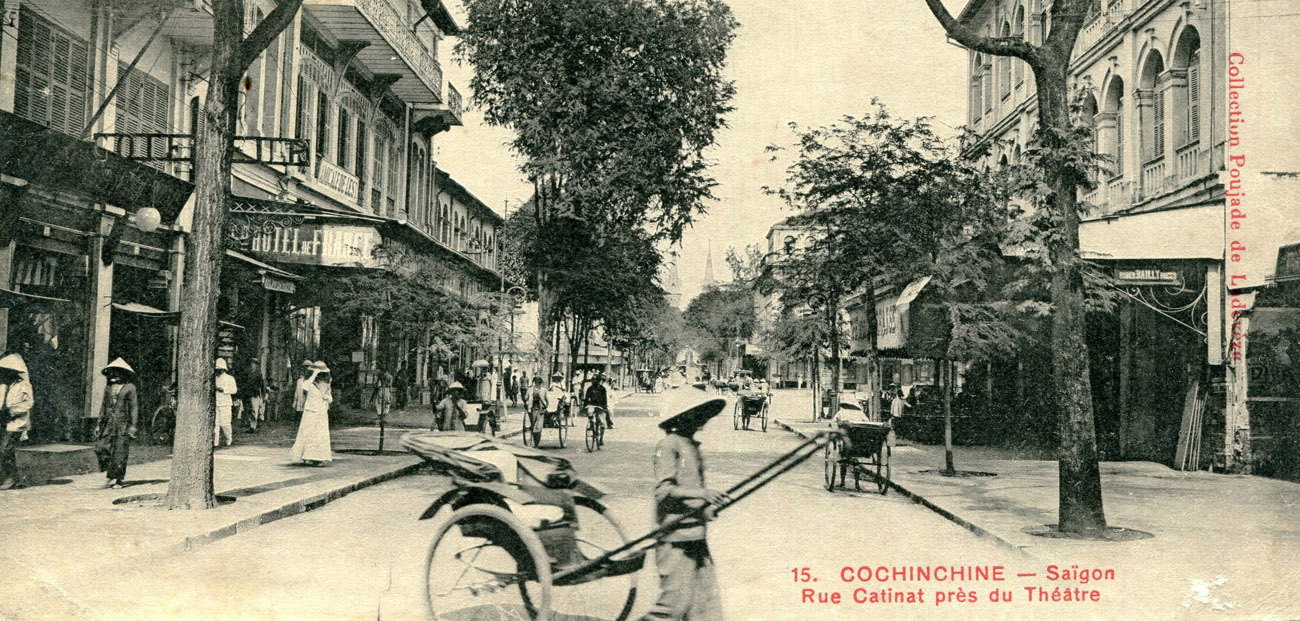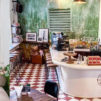
The postcard that launched a lovely little business:
Cochinchine: Saigon, Rue Catinat pres du theatre. An evocative image taken by French photographer, Poujade de Ladaveze, at the turn of the 20th century. I sourced this image back in 2009 from a French postcard enthusiast/collector who was living in Ho Chi Minh City at the time. It is the postcard that launched our business in 2010 and it remains one of our most popular and endearing images within our Indochine B&W range.
Rue Catinat, now known as Dong Khoi Street, continues to be one of the most beautiful, charming and expensive streets in downtown Saigon/Ho Chi Minh City. Take a leisurely stroll up its length and you will wonder past glamorous boutiques, cafes and department stores. Fortunately, there are still a number of French architectural gems that still call the street home. Walking up from the Saigon River, these include high end hotels such as the Majestic (built in 1930), the Grand (1925) and the Continental (1880), Saigon’s Opera House (1898), the lovely but lesser known art deco style Catinat Building (1926) and finishing with Notre Dame Cathedral (built in 1863) at its north western end.
With the exception of the cathedral, with its spires towering above the tree-line, all of the other buildings in the postcard image remain out of site. This photo was taken a little down the street from where The Caravelle is now located. The Saigon Opera House, which was built in 1898, is still a beautiful feature along Dong Khoi, sitting opposite and hidden from the Caravelle. Both of these buildings would be on the right hand side of the postcard. The photographer was facing towards Notre Dame with his back turned to the Saigon River. If you wanted to replicate this image, as I have often thought I would do, beware of the traffic. It’s certainly not as relaxed looking now as it is in the postcard.
Rue Catinat is a street that oozes charm, wealth and prestige. The contradiction of life for the French versus that of the local population in the early 1900s is clearly evident: on the one hand, there’s a French officer and a woman wearing her finest, strolling down the beautiful tree-lined street. This is in contrast to the local women wearing their conical hats and their plain Vietnamese style clothing and the pousse-pousse/rickshaw riders, who plied their trade by running barefoot whilst pulling behind them a two-wheeled cart with one or two paying passengers.
The street has undergone a long history of renaming, reflecting the various power dynamics at the time of each change. In 1865, the French named it Rue Catinat; from 1955 to 1975 during the American/Vietnam war when the southern Vietnamese government were still in power, it was renamed Tu Do or Freedom Street; and following the fall of Saigon and the end of war, it was renamed and given its current name of Dong Khoi, meaning Total Revolution.
We have a range of products from our Indochine B&W range which feature this vintage image of Rue Catinat, including cushion cover designs, a tea towel, travel pouch and tote bag.





